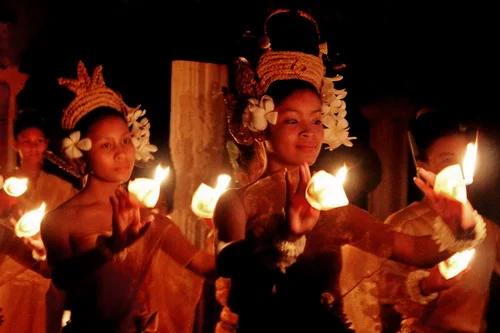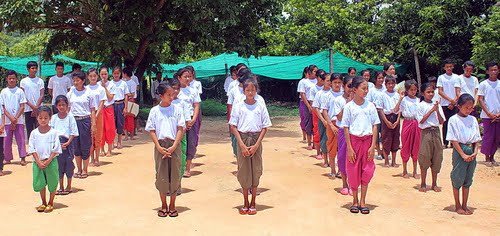Rare Rituals of Cambodian Dance Revealed in Buddhist Temple

This royally-sanctioned rural Cambodian dance troupe performs ancient dance rituals to re-sanctify Khmer temples and bring blessings to the land and people of Cambodia.
Special thanks to author Claire Byrne and the Phnom Penh Post for their permission to reproduce this article. Copyright © 2012 The Phnom Penh Post. All Rights Reserved.
Siem Reap, Cambodia – It’s a Wednesday night in monsoon season. Outside, the rain is falling so hard visibility is limited, the ground is wet and muddy and there’s a sense of urgency to get indoors.
But inside the pagoda in Wat Bo, calm has descended. In a serene, candlelit chamber within its walls a small group are gathered to witness a rare performance by the Preah Ream Buppha Devi Chhouk Sar Dance School, which comprises a group of dancers who come from zinc houses and straw huts in Banteay Srei, rather than the plush villas and high rise apartments of the capital which are usually home to would-be ballerinas.
As that unmistakable ting ting ting of the Cambodian instruments begins, and as the children start to dance all are entranced: not just the audience, but the dancers too. Utterly composed and focused on their art, even a mini fire during the candle dance fails to make these pros flinch. The children are poised, graceful and incredibly talented.
“Their movement, their rhythm, it’s incredible, they’re very much guided by something. There’s a spiritual force which is channelling through them,” explains the conservatoire’s founder Ravynn Karet Coxen.

After establishing the music and dance program of her Bantaey Srei-based organisation, Nginn Karet Foundation for Cambodia, five years ago, Ravynn knew she had to set hers apart from the dance schools of the urban elite.
Even with HRH Princess Norodom Buppha Devi as patron, her group was never going to compete with the Royal Ballet. She needed a unique selling point.
And so began a series of sacred rituals, visiting temple after temple, Angkor Wat, Bayon, River of a Thousand Lingas, and of course Banteay Srei, with an aim of re-sanctifying the temples.
“To create an identity we began to do the sacred ritual,” explains Ravynn. “To implore the relevant deity to come and bestow their spiritual force in the temple, you have to have an energy, and what’s more fitting than the children from the earth of Angkor to do this?”

And fitting it is. The dance school itself is nestled right in the middle of a quadrant of Cambodia’s most sacred and historical sites. Overlooked by Phnom Kulen, Phnom Dei and Kbal Spean, the children of seven villages around Banteay Srei come to the dance centre every day to learn one of three disciplines: music, folk, or classical dance.
Like a Cambodian version of Fame, children from as young as three, dressed in brightly-coloured kben spend hours honing their skills. Along with dance or music, the 178 students partake in English lessons, classes in sustainable ecology, are taught about health and hygiene and also learn other Cambodian fine arts such as shadow puppetry and embroidery.
Proving their dedication, some of the older children have to cycle four hours a day to and from the nearest secondary school before dance training. But Ravynn says since last year’s flash floods in the area, it has been harder and harder to ensure attendance.
“A lot of our children are abandoning dance school because they have no energy, they are exhausted. I lost a lot of children after the flood. The ones who were 17, 18, they’ve gone to the border, they’ve gone to Thailand to work. Some of them have enrolled in the military, while others have to work in the fields after school.”
It is because of this Ravynn, who strictly limits where the children perform, has decided to begin a schedule of events both at the conservatoire’s centre in Banteay Srei and a regular performance in association with Amansara at Wat Bo.
“If you live in the countryside, you’ve never seen the city, you’ve never seen a theatre, so they don’t know what they’re working towards. That’s why they need to perform.”

But Ravynn is fiercely protective of the children and doesn’t want them to appear as performing monkeys.
“You have to treat it like something special, we have to perform in the correct places, with the correct audience, not in front of people who are eating and drinking and chatting. You have to respect this culture, to know that you are witnessing it something special.”
She is highly critical of the tourist-trap dancing in bars and restaurants.
“They are completely devaluing the ballet. Dancers cannot wear the full regalia unless they have been training for 12 to 15 years. It’s not just for entertainment, it’s an art, it has to be exclusive, it has to be unique.”
For Ravynn, her dream is to begin touring with the dance school and to one day establish a boarding school-type conservatoire.
“This is vocational training this is to give them a job,” she explains, “To create a dance company which is going to perform nationally, internationally, to be invited to international dance festivals, and then to teach the generation after them.”
To attend one of the Preah Ream Buppha Devi Chhouk Sar Dance School performances contact nkfc@nkfc.org for more information.
